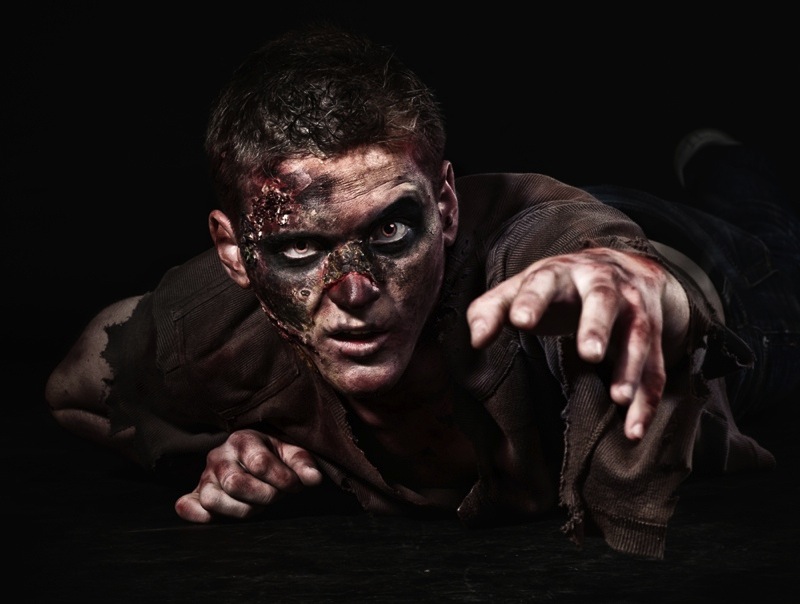Zombie Neuroscience: Inside the Brains of the Walking Dead

The rotting flesh, the shuffling walk, the unintelligible groans — it's not hard to spot a zombie at a glance even among the most gruesome of Halloween monsters. But what's going on inside their brain?
Based on fictional accounts of the undead creatures' bizarre behavior, several prominent scientists have taken a crack at the mystery. Neuroscientists Bradley Voytek, of the University of California, San Diego, and Tim Verstynen, of Carnegie Mellon University, are both avid zombie fans. Back when they were in graduate school together, they would sit around watching zombie movies and got to thinking about what causes zombies to behave as they do.
"We mocked up what a zombie brain would look like," Voytek said, and "it kind of took off." Voytek calls it a way of getting people to accidentally learn something about the brain. [Zombie Facts: Real and Imagined (Infographic)]
Diagnosing a zombie
Broadly speaking, zombies can be either slow zombies (think the original "Dawn of the Dead") or fast zombies (à la the film's 2004 remake). Slow zombies shuffle in an uncoordinated manner and can't open doors, suggesting a problem with the cerebellum, Voytek said. This region at the back of the head, known as the "little brain," plays an important role in coordinated movements. Tasks such as picking up a quarter on the ground are actually really hard, Voytek said. "We still can't get robots to do this."
All zombies — fast ones included — seem to have poor memory and lack the ability to plan as a group.
"They don't really have any social skills," Voytek said.
Get the world’s most fascinating discoveries delivered straight to your inbox.
They also lack cognitive control — there's no delaying the gratification of warm human flesh. These symptoms suggest their frontal lobes probably aren't functioning correctly, Voytek said. In animal studies, cutting connections to the frontal lobes causes lots of problems, he added.
Then there's the matter of zombie communication, or lack thereof. Voytek and Verstynen made a educational video in which they "diagnosed" zombies with a condition called Wernicke's aphasia, which results from damage to a bundle of connections between the brain's temporal and parietal lobes. Of course, brain damage is not a joking matter, Voytek said, but he finds it interesting to think about. [The 9 Most Bizarre Medical Conditions]
Zombies may have impaired brain function in many ways, but they do have a razor-sharp sense of smell — at least when it comes to sniffing out living human flesh. In a scene from the movie and comic book "Walking Dead," the protagonists smear themselves with the organs of dead zombies to prevent "live" zombies from smelling them.
By comparison, healthy humans are thought to have a poor sense of smell. But studies have shown that people can track scents really well if they focus on the task, Voytek said. In one study, blindfolded undergraduates at the University of California, Berkeley, were able to track a streak of chocolate in the grass by smell alone, and did it surprisingly well. So the zombie's ability to tell healthy bodies from decaying ones (i.e. other zombies) is "certainly plausible," Voytek said.
Real-life zombies?
All of these theories about zombie neuroscience are idle speculation. But could zombies exist in real life? The concept of zombies has its roots in Haitian lore, in which voodou (or voodoo) priests create a powdery substance that allegedly turns people into zombies. A component of this powder is a nerve toxin from pufferfish capable of keeping people in a state of suspended animation. Haiti has actually banned the practice of making these human zombies.
The animal world has its own share of zombie stories. A fungus that infects carpenter ants causes the insect to climb underneath tree leaves and die. The fungus sprouts a stalk from the zombie ant's head, sending out a shower of spores to infect other ants.
Wasps are known to inject their venom into cockroaches, paralyzing but not killing them. The wasp drags the helpless roach to its nest and lays its eggs inside the bug's abdomen. When the baby wasps hatch out, they eat the cockroach alive from the inside out.
And, of course, there's the Toxoplasma gondii parasite, which can infect humans. In rats, the parasite makes rodents stop fearing the smell of cat urine, which usually proves fatal for the rats. In pregnant women, toxoplasma infection can cause congenital problems such as deafness or mental retardation in the baby.
But when it comes to flesh-eating, shuffling monsters, the zombie phenomenon remains firmly rooted in fiction.
"No kind of brain damage could make anything like a zombie happen," Voytek said.
Follow Tanya Lewis on Twitter and Google+. Follow us @livescience, Facebook & Google+. Original article on LiveScience.



